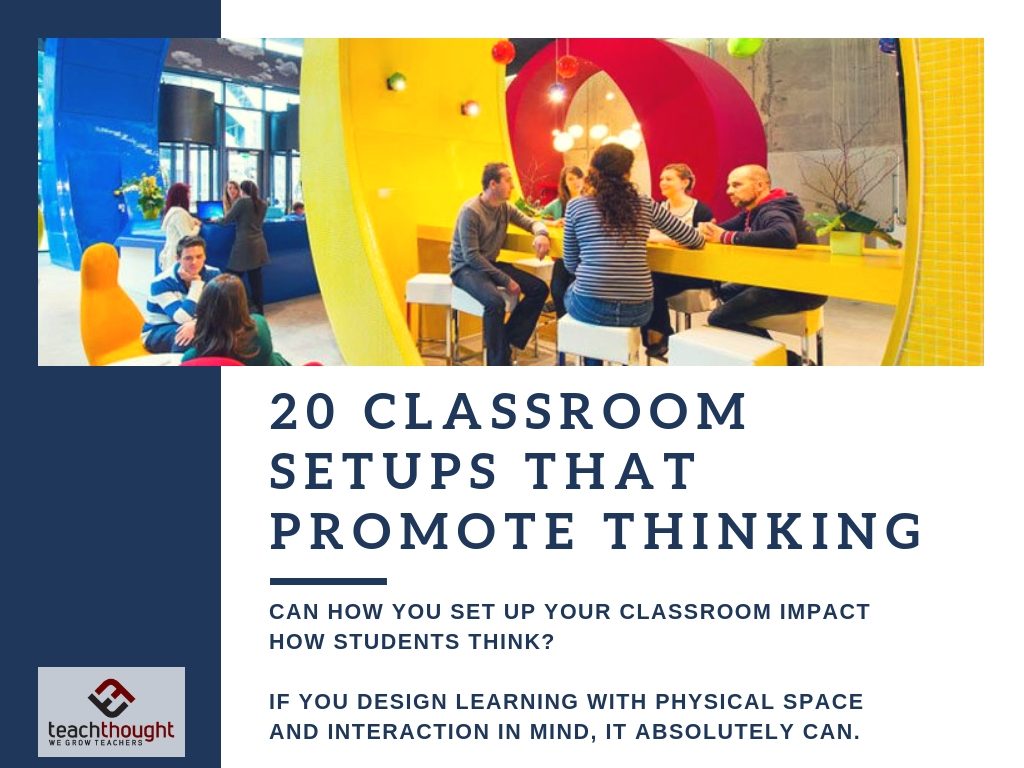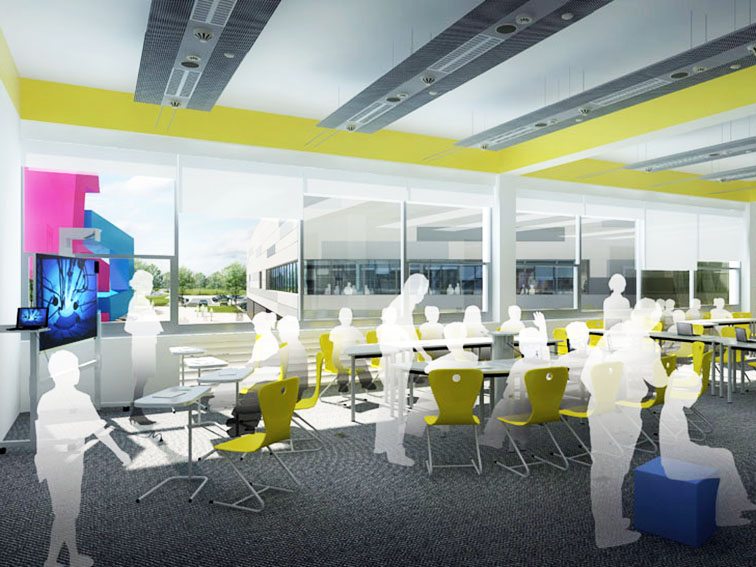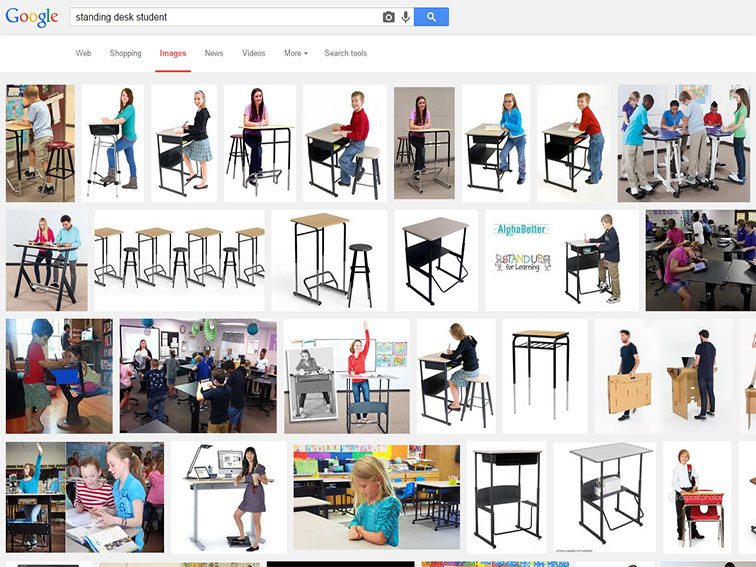
What Classroom Setups Best Promote Critical Thinking?
If you design learning with physical space and interaction in mind, it absolutely can.
Desks are a staple of the ‘modern’ classroom as we know it. Usually, these learning spaces are simple, and simply arranged: places for students to sit and read and write, lined up neatly in rows. While progress has been in the design of schools and classrooms, it’s usually only in pockets of well-funded ‘future schools’ with very little application for the rest of us.
So what can we do? That’s the point of this post. If you think of the following ideas as exactly that–ideas–then you’ll realize that none of these are either good nor bad. They’re ideas. If they are used well to solve a problem or promote a characteristic, they are being used well; if they don’t, they’re not. Many of these aren’t immediately reproducible in your own classroom. They may not work for your grade level or furniture or budget or content area. But you can take it as an idea, learn from it, and use it (or not) accordingly.
So, the bit about ‘classroom setups impacting thinking.’ Learning is an ecology. Classroom design impacts classroom management impacts curriculum needs impacts lesson and unit design impacts teacher personality impacts technology needs impacts literacy strategies and teaching strategies, and so on. Each one of these possibilities will only work as well as you are able to adapt the way you plan instruction and design learning experiences. Yes, you can design a classroom using a Fishbowl approach–and not just to host a Fishbowl discussion, but for longer periods of time.
You can also set up a ‘Google Room’ or ‘Maker Space’ and not promote thinking at all, or have students performing stunning cognitive acrobatics sitting by themselves on a cold floor. The idea here is that new ways to set up your classroom can help you think differently about how and why you use certain arrangements, and then design more intentionally moving forward (even if you just stick to plain ol’ rows).
In fact, if you think of rows and rows of desks as having pros and cons, causes and effects, you’ll see that these rows lend themselves well to certain things (organization, paper passing, etc.), while not so well to others (collaboration, movement). You’ve already (perhaps unwittingly) adapted your instruction to whatever design you normally use. You plan with it in mind. If you take a new approach, you’ll need to design with that in mind as well. And that’s where the actions and behaviors that promote thinking–interaction, movement, study, making, collaboration, thinking alone, and so on–become a factor.
Note, we’ve placed an asterisk* beside those approaches that are more strongly suited to ‘thought’ than others. With that preface, on to some of the possibilities (there are many more!).
20 Ways To Setup A Classroom To Help Your Students Think
1. Maker Spaces

How this is structured depends on your space, content area, grade level, etc. But any content area can use ‘making’ as a primary teaching and learning strategy, and to do so, you’ll need to create the spaces for that to happen. A mix of the ‘Learning Labs’ approach and the ‘Google Room’ may work well.
2. Geometric Mix

This approach takes a mix of forms–rows, groups, semi-circled tables. While the furniture in the pic above may be beyond your reach, you can produce a similar effect with a combination of tables and desks.
3. Differentiation Stations*
This is physical grouping, but based on areas of differentiation–background knowledge, reading level, an individual skill, etc. If instruction is tailored for a student in this way–with their Zone of Proximal development–there is more opportunity for thinking, teaching, and learning that ‘fits.’
4. Fishbowl*
Also a teaching strategy, Fishbowls sees a group of students in the middle, and a group on the outside in a circle facing the group in the middle. You can also arrange your classroom this way permanently–or at least for an extended period of time. The ‘fish’ in the middle have one function (e.g., reading roles from a play, solving a problem, analyzing art, etc.) while the group on the outside participates in a #backchannel twitter chat with a love running log on a screen. Here, everyone can have a voice–and an opportunity for thought.
5. One Group + 4 Rows
This one is what it sounds like it’d be–one group complemented by 4 rows. This setup could be useful if the majority of the class is often working on one activity–or part of an activity, while the bulk of the class works on something else. It obviously can be used collaboratively as well.
6. 2 Groups + 2 Rows

Same as above, but more of the class is in a group this time, so the class is split more evenly.
7. Function Pods*
This one is similar to Differentiation Stations, only the idea here is less about differentiation and more about a task. Think literature circles, for example, where everyone has a role. The difference here is that the whole classroom is set up that way.
8. A ‘Google Room’*

Think colors. Lots of colors. Shapes and textures, too. Diverse lighting sources. A lot of natural light, if possible. Areas to work alone, in pairs, or in groups. Sitting. Standing. Openness. Collaboration. May not be possible to realize completely, but you could use it as inspiration.
9. Two Sides*
You can also split the classroom into ‘two sides.’ This may be comprised of rows, but the room is set up in halves oftentimes facing one another. This can be especially effective for Social Studies classes, or other content areas that use Accountable Talk as a teaching strategy.
You can also have the two sides comprised of angled rows. This isn’t a huge change from traditional rows, but it does offer a few advantages if you’ve got the room, namely that students are in the line of sight of one another more naturally.
10. Giant Oval
Usually, this is used for team-building activities, but it’s possible to run a classroom this way for a full unit if you plan for it effectively. Maybe a steady diet of agree/disagree, debate, Socratic Seminars, and Accountable Talk, for example.
11. Teacher In The Middle
Picture a ‘regular classroom,’ but with the teacher (and their desk, if they have one) in the middle. Changes the dynamic of the classroom quite a bit. Whether that’s an effective teaching tool or not depends on how you use it (the same goes with all of these, I suppose).
12. Standing Desks

They’re out there. Write a grant proposal, put your desk in the middle, and make it work.
13. Horseshoe
An oval with one end missing. Kind of. Not sure this would be very effective long-term, but for a reading activity or a write-around (which are terribly underrated as teaching strategies), it’d work swimmingly.
14. Two Circles
Circles allow students to face one another and encourage conversation. It’s not ideal for small group work, but fordirectn instruction and literacy activities, it has potential. One giant circle may not work well for a daily setup, but two circles might. With two circles, the size is obviously reduced compared to one, giving you a bit more flexibility for classroom management.
15. Rotating Groups*
This is less about the shape of the desks, and more about the workflow and lesson design. The idea here is to plan lessons and units that require students to work together with different groups for different reasons, and to keep them moving, whether within one class, one week, or the unit overall.
16. Middle Circle, Outer Square
Putting a square on the outside and circle on the inside–or even vice-versa–is really just a ‘geometric variation’ of the fishbowl, but the size of the circle can be adapted for daily use by a large cluster of students.
17. Learning Labs*
If you can recall back to the high school science lab–high desks, ‘things’ to tinker with, students standing and moving around small areas of collaborative learning space–that’s the idea of learning labs. This can be used in any content area and any grade level, and doesn’t even necessarily require hands-on manipulatives. Students standing around a high desk solving physics or geometry problems while ‘mixing’ isn’t a management nightmare if you’ve planned a lesson with this approach in mind.
18. A Learning Studio*
This is one example non-traditional classroom setups–imagine a Starbucks mixed with a library mixed with a classroom mixed with a maker space mixed with a design studio. Probably wouldn’t work if you have 35 students, but if you have less than 20, this kind of approach could change the culture of learning in your classroom.
19. Open Square
Similar to #10, this one came on twitter from @rmg178, “I do an open square with the open side facing the board & I put a table in the middle for my materials.”
20. Fluid
Change your classroom setups weekly. Let the learning goals dictate how you use your space–and how students use their individual spaces. A fixed learning space reflects a fixed mindset. It’s not ‘a lot of work,’ it’s adapting.
20 Ways To Setup A Classroom; 20 Classroom Setups That Promote Thinking; adapted image attribution Google, flickr user makerfestivaltoronto, bsfinhull
